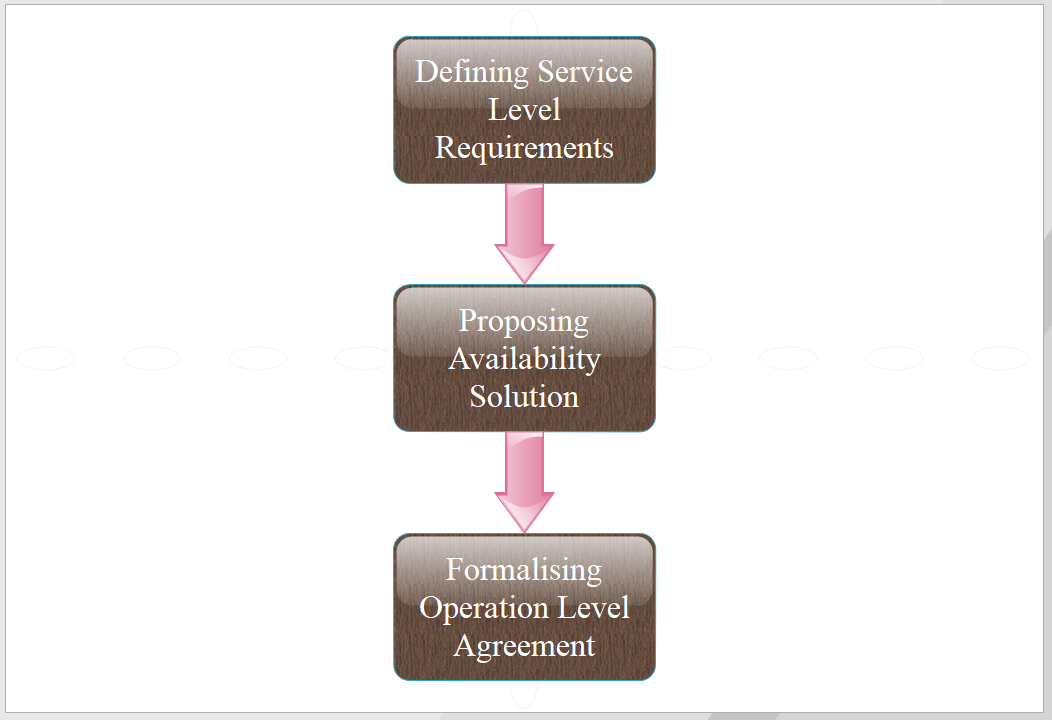What is Availability Management
Availability Management aims to define, analyze, plan, measure and improve all aspects of the availability of IT services. It is is responsible for ensuring that all IT infrastructure, processes, tools, roles etc are appropriate for the agreed availability targets.
- Availability refers to the ability of a service or component to perform the function as desired at a stated instant or over a stated period of time.
- The goal of the availability management is to make sure that any give IT service delivers its functions consistently and cost-effecctively at the level of service availability that the customer requires.
- It optimises the capability of the IT infrastructure, services and supporting organisation to deliver a cost effective and sustained level of service availability that meets stringent business objectives.
- Availability management is used to ensure application systems stay available. This usually means making sure everything is up for use under the conditions of service level agreements (SLAs).
- Availability management is also a part of the ITIL service delivery framework.
- To do this, the availability management team reviews business process availability requirements. Then, they make sure the most cost-effective contingency plans are in place. These plans are tested on a regular basis to make sure your business needs are met.
- Availability Management, There is a close relation between capacity management and availability management processes.
- They both use many common tools and techniques to identify faults in the components.
- Availability management also plays a lead role in component failure impact analysis (CFIA) and service outage analysis (SOA) initiatives.
- Typically, the available management team determines the cause of the problem. Next, they analyze any related trends. Finally, they take the next steps to ensure service availability meets SLAs.
- Availability management focuses on two distinct areas:
- New IT service, provide the best opportunity to an organisation for achieving desired avilability targets in a cost-effective manner because availability considerations can be built from the earliest stages by selecting suitable technologies and an efficient IT support infrastructure.
- Existing IT service, It may require considerable amount of short-term effort to improve levels of availability.
Availability Management Process Flow

Availability Management - Scope
The scope of the availability management process covers the design, implementation, measurement, management and improvement of IT service and component availability.
- Monitoring of all aspects of availability, reliability and maintainability of IT services and the supporting components, with appropriate events, alarms and escalation, with automated scripts for recovery.
- Maintaining a set of methods, techniques and calculations for all availability measurements, metrics and reporting.
- Actively participating in risk assessment and management activities.
- Collecting measurements and the analysis and production of regular and adhoc reports on service and component availability.
- Understanding the agreed current and future demands of the business for IT services and their availability.
- Influencing the design of services and components to align with business availability needs.
- Producing an availability plan that enables the service provider to continue to provide and improve services in line with availability targets defined in SLAs, and to plan and forecast future availability levels required, as defined in SLRs.
- Maintaining a schedule of tests for all resilience and fail-over components and mechanisms.
Advantages of Availability Management
- Availability Management ensures that new products and service fulfil the availability requirements and availability standards that are agreed with the customer.
- The associated cost is acceptable.
- It makes sure that the availability standards are monitored continuously and improved.
- In case of the unavailability of the service, it ensures that corrective action is taken when the service is unavailablr and tries to minimise unavailability duration.
- It is easy to prove its added values for an organisation which follows availability management in providing its services.
Cost of Availability Management
The costs of Availability Management includes following major components:
- Cost of Implementation :It includes cost of implementation of availability management in the organisation.
- Personnel Costs :This is the cost incurred in providing training to personnel.
- Facilities Costs :This is the cost which is required to provide various facilities to customers.
- Measuring and Reporting Tools : It relates to the cost incurred in measurement and reporting tools.
Relationship with other Processes
Availability management is closely related to other service delivery processes.
- Service Level Management.
- Financial Management.
- IT Service Continuity Management.
- Capacity Management (CapM).
- Change Management (CM).
- Problem Management (PM).
- Incident Management (IM).